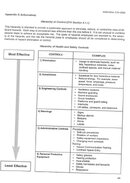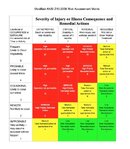The highlighted text is true only for single hose regulators, but not for double hose regulators. For decades double hose regulators were the standard for diving in the Antarctic. But they were discontinued by the manufacturers, fell into disrepair, started leaking sea water into the case, and then freezing up, so were discontinued. But double hose regulators have a distinct advantage over single hose regulators, in that both the first and second stages are isolated from the water. The double hose regulator therefore will not freeze up under normal use.“A freeflow is just one example, other failures are possible and you don’t want it to be a death sentence.”
Freeflows will happen, usually first stage freeflows, no matter what OC kit is used, expanding gas gets cold and freezes stuff. People do actually die this way, a member of another local club died about three years ago due to a freeflow. It is not if but when.
Really a lot of what we teach people is about redundancy. Initially that comes from a buddy, eventually from kit and a buddy, and then for solo just from kit. I don’t expect kit to fail, it almost never happens, but freeflows are common.
Personally I use Apeks regulators. I think they are excellent and very suitable for deep cold water, however I wouldn’t bet my life on taking just one on a dive.
Concerning single hose Regulators and freeze-up, here's an interesting study:
I will have more to say later.BACKGROUND: Single-hose scuba regulators dived in very cold water have a probability of experiencing first- or second-stage malfunction yielding complete occlusion of air flow or massive free flow that rapidly expends a diver's air supply, both conditions referred to as regulator "freeze-up". Principal factors contributing to ice crystallization in the regulator second stage include manufacturer's design, materials, and quality control, exhalant breath of diver, adiabatic gas expansion, mass flow, time, and temperature. MATERIALS AND METHODS: 11 divers (mean height 180.1 cm, mean weight 84.6 kg) logged a total of 133 dives in -1.86 C sea water under 6-m thick Antarctic fast ice. Dive profiles had an average depth of 38 msw and dive time of 29 min, including a mandatory 3 min safety stop at 6 msw. Twenty-seven commercially available, unmodified regulator units from 9 different manufacturers underwent standardized pre-dive regulator care and were randomly assigned to divers. Depths and times of onset of second-stage regulator free-flow were recorded. RESULTS: In 133 dives, there were 28 free flows. The free flows were not evenly distributed across the regulator brands. The regulators classified for the purpose of the test as "better" suffered only 5 free-flows out of 77 exposures (6% combined incidence), and the others suffered 23 out of 56 exposures (41% free-flow incidence). Testing on three regulators was aborted when free flow incidence reached 50%. Differences between regulator free-flow incidences were tested by the Chi-square test. The pooled incidences for the four best performing regulators were compared to the five remaining regulators. The differences between the groupings was significant at P<0.001. CONCLUSION: Regulator freeze-up is a probabilistic event; even the best regulators can fail under polar conditions. Combined laboratory and field-testing, proper pre-dive regulator care, depth-dependent gas density control, breathing rate, and diver experience can influence freeze-up incidence.
[abstract] SCUBA REGULATOR PERFORMANCE FOR UNDER-ICE SCIENTIFIC DIVING OPERATIONS
SeaRat





